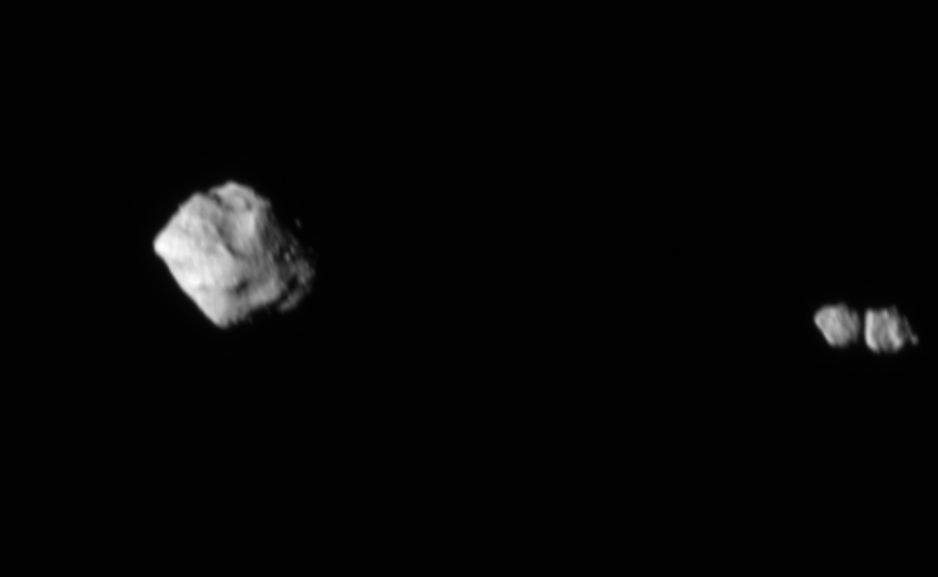Finding The Age Of A Contact Binary “Moon”
By Andy Tomaswick
There are millions of asteroids floating around the solar system. With so many of them, it should be no surprise that some are weirdly configured. A recent example of one of these weird configurations was discovered when Lucy, NASA’s mission to the Trojan asteroids, passed by a main-belt asteroid called Dinkinesh. It found that Dinkinesh had a “moon” – and that moon was a “contact binary”. Now known as Selam, it is made up of two objects that physically touch one another through gravity but aren’t fully merged into one another. Just how and when such an unexpected system might have formed is the subject of a new paper by Colby Merrill, a graduate researcher at Cornell, and their co-authors at the University of Colorado and the University of Bern.
The paper, in particular, looks at when the system might have formed and does so through modeling. A theory in asteroid formation called the binary Yarkovsky-O’Keefe-Radzievskii-Paddack effect, which, since no one wants to say the full name, is shortened to the acronym BYORP. This model explains how binary asteroid systems happen in the first place.
Essentially, the asteroid speeds up its rotation due to radiation pressure. Eventually, due to those rotational forces, it gets to a point where its gravity is no longer capable of holding all of its material on its surface, and some of that material is ejected out into space, eventually coalescing into a “moon” for the slightly larger asteroid.
Credit – NASA Goddard YouTube Channel
Dinkinesh isn’t a “large” asteroid by any measure – at its widest point, it only measures about 790 meters in diameter. It’s also named after the Amharic word for Lucy; the fossil remains of a potential human ancestor found in Ethiopia and the namesake of NASA’s mission. Its satellite, Salem, is the Amharic word for “peace,” but another fossil set found in 2000 which, though that of a child, predated Lucy’s by 100,000 years. But it is even smaller than Dinkinesh – only about 220 m at its widest point.
But Selam actually has two widest points because it is shaped in what is technically called a bilobate but is more commonly thought of as a “dumbbell” shape. This might be partially due to another force that influences the formation of asteroids—tides.
Traditionally, people think of tides as caused by our Moon moving around the Earth. However, tides can also happen on the insides of asteroids when there is a gravitational force on a small body by an even smaller one that happens to be nearby. For example, Selam induces tides on Dinkinesh, and understanding how the two developed together requires understanding how those tidal forces played out.

Credit – NASA/Goddard/SwRI/John Hopkins APL/NOIRLab/Brian May/Claudia Manzoni
Modeling both tidal forces and the BYROP acceleration process is complex mathematically. This is especially true because the inputs to the equations used to model them contain plenty of uncertainties. Luckily, there is a mathematical technique to help with that.
The Monte Carlo method uses statistics to find a “correct” answer by varying the inputs to equations and randomly sampling the results. The authors used this technique to determine how long the Dinkinesh / Selam system had been in orbit around each other, using inputs like each object’s sizes and orbital speeds. They came up with an answer of between 1 and 10 million years – not very long in the grand scheme of the solar system’s evolution.
Given that binaries are thought to make up at least 15% of near-Earth asteroids, and contact binaries make up between 14% and 30% of small bodies that are still larger than 200 m, studying these kinds of unexpected systems could prove fruitful in understanding how asteroids more generally are formed. As the paper mentions, more work is needed, especially an analysis of the craters present on Selam, which could provide an alternative view of its age. Given that we only just discovered this binary system by chance in November 2023, that data, and much else from the Lucy mission, will doubtless be forthcoming soon.
Learn more:
Merrill et al. – Age of (152830) Dinkinesh I Selam constrained by secular tidal-BYORP theory
UT – Contact Binary Asteroids are Common, but We’ve Never Seen One Form. So Let’s Make One
UT – Awesome Radar Images Reveal Asteroid 2014 HQ124’s Split Personality
UT – What? Wow! That New Asteroid Image from Lucy Just Got Even More Interesting
Lead Image:
Dinkinesh and Selam in situ via a Lucy snapshot.
Credit – NASA/Goddard/SwRI/John Hopkins APL
The post Finding The Age Of A Contact Binary “Moon” appeared first on Universe Today.

May 23, 2024 at 12:40AM
via Universe Today read more...

Post a Comment